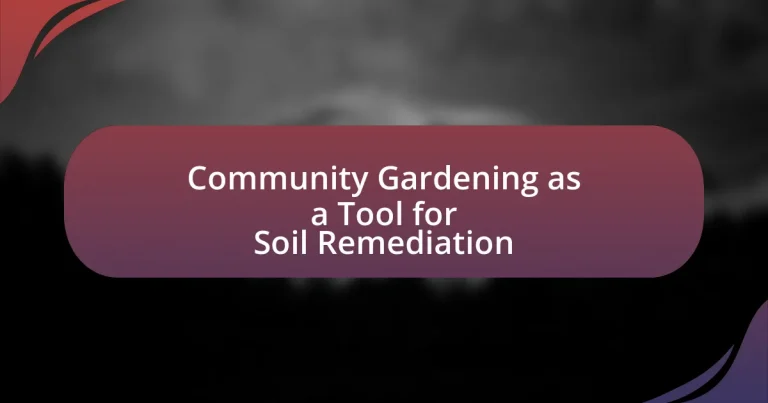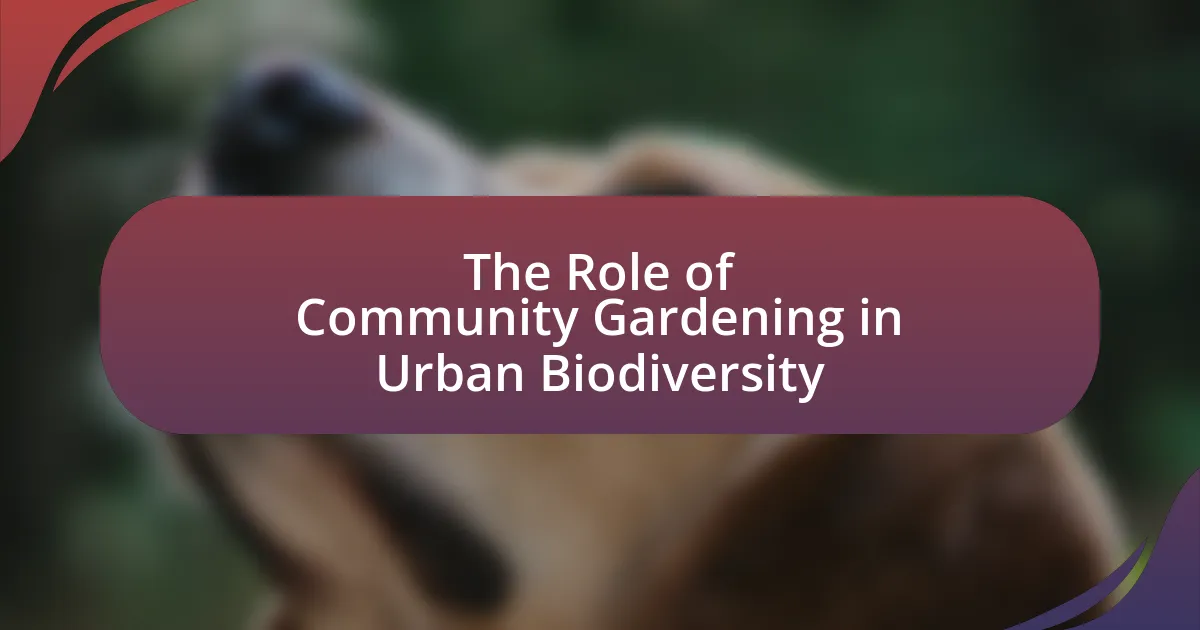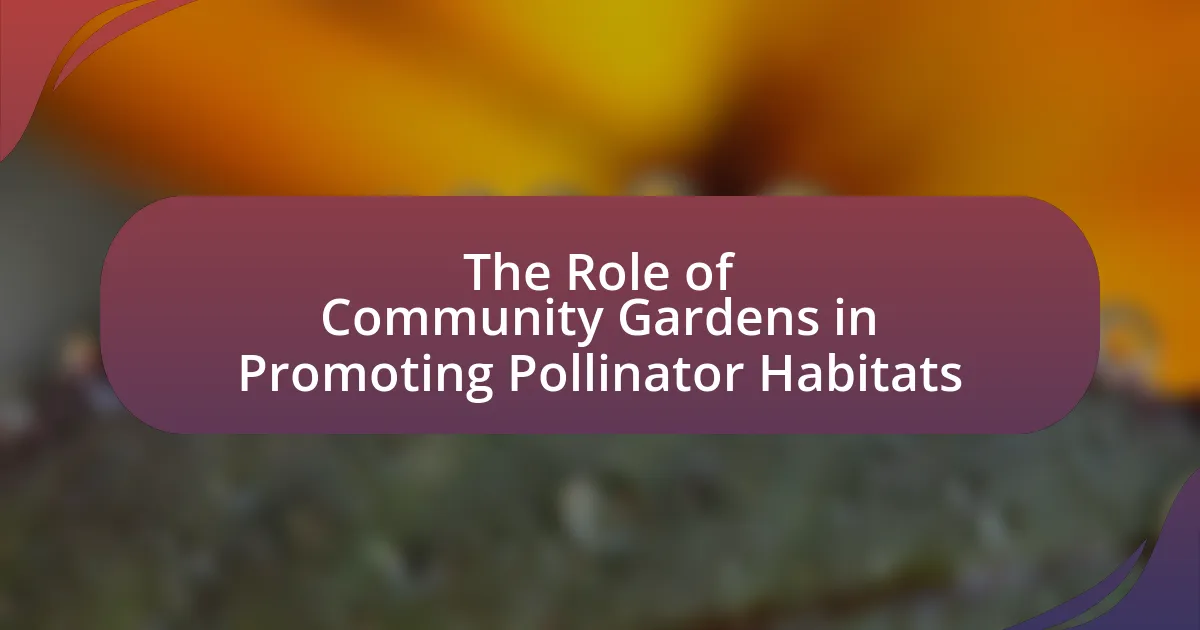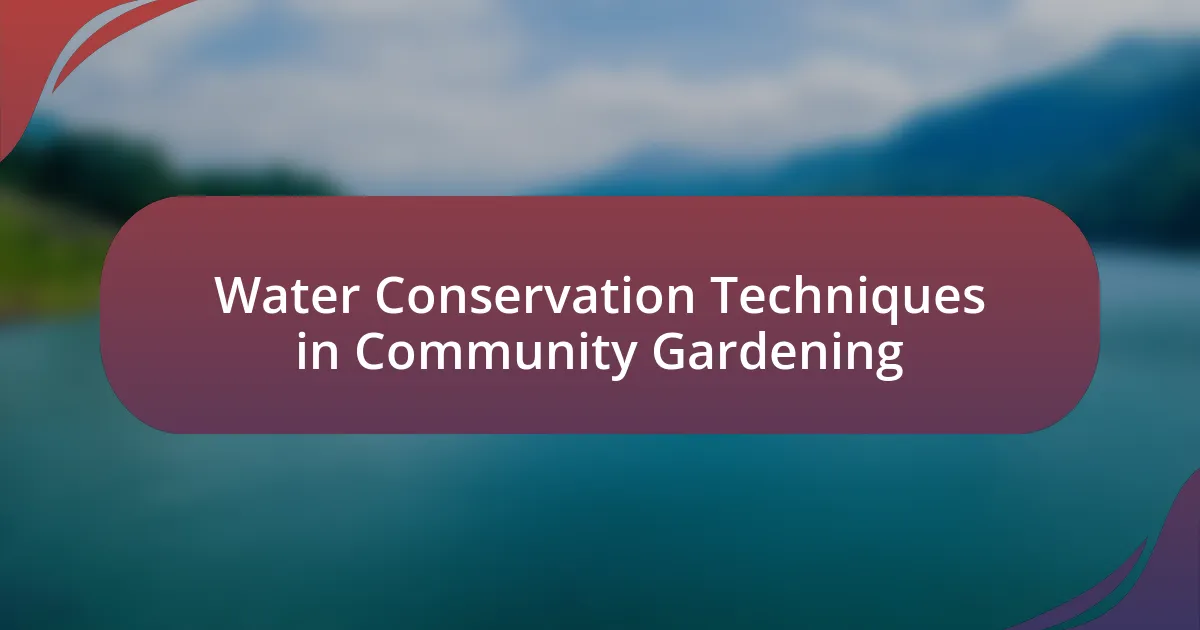Community gardening is an effective tool for soil remediation, utilizing collective efforts to improve soil health and restore contaminated land. This practice involves cultivating plants that can absorb pollutants, enhance soil structure, and promote biodiversity, with specific species known as hyperaccumulators capable of extracting heavy metals and toxins from the soil. The article explores how community gardening contributes to soil health, the types of contaminants it can remediate, and the importance of community engagement in these initiatives. It also discusses best practices for implementing successful gardening projects aimed at soil remediation, the challenges faced, and the long-term impacts on both soil quality and community well-being.

What is Community Gardening as a Tool for Soil Remediation?
Community gardening serves as a tool for soil remediation by utilizing collective gardening efforts to improve soil health and restore contaminated land. This practice involves the cultivation of plants in shared spaces, which can help to absorb pollutants, enhance soil structure, and promote biodiversity. Research indicates that certain plants, known as hyperaccumulators, can extract heavy metals and other toxins from the soil, effectively reducing contamination levels. For example, a study published in the journal “Environmental Science & Technology” by authors such as Zhang et al. (2018) demonstrates that community gardens can significantly lower soil lead concentrations through the cultivation of specific plant species. Thus, community gardening not only fosters community engagement but also plays a vital role in environmental restoration and soil health improvement.
How does community gardening contribute to soil health?
Community gardening contributes to soil health by enhancing soil structure, increasing organic matter, and promoting biodiversity. The practice of growing diverse plants in community gardens improves soil aeration and drainage, which are essential for root development and microbial activity. Additionally, the incorporation of compost and organic materials in these gardens enriches the soil with nutrients, fostering a healthier ecosystem. Research indicates that community gardens can increase soil organic carbon levels by up to 30%, which is crucial for soil fertility and overall health. Furthermore, the variety of plants grown attracts beneficial organisms, such as earthworms and pollinators, which further enhance soil quality and resilience.
What specific soil contaminants can community gardening help remediate?
Community gardening can help remediate specific soil contaminants such as heavy metals, particularly lead, cadmium, and arsenic. Research indicates that certain plants, known as hyperaccumulators, can absorb these contaminants from the soil, thereby reducing their concentration. For example, studies have shown that plants like sunflowers and mustard greens can effectively uptake lead and other heavy metals, making community gardens a viable method for soil decontamination. Additionally, organic practices in community gardening, such as composting and phytoremediation, further enhance the soil’s health and reduce harmful substances.
How do plants used in community gardens affect soil quality?
Plants used in community gardens enhance soil quality by improving its structure, fertility, and microbial activity. The diverse root systems of these plants help aerate the soil, reduce compaction, and promote water infiltration. Additionally, plants contribute organic matter through leaf litter and decomposing roots, which enriches the soil with nutrients. Research indicates that certain plants, such as legumes, can fix nitrogen in the soil, further boosting fertility. Studies have shown that community gardens can increase soil organic carbon levels by up to 30%, demonstrating their effectiveness in soil remediation.
Why is soil remediation important in urban areas?
Soil remediation is important in urban areas because it addresses contamination that can adversely affect human health and the environment. Urban soils often contain pollutants from industrial activities, heavy metals, and chemicals, which can lead to health risks such as respiratory issues and cancer. For instance, a study by the U.S. Environmental Protection Agency indicates that urban soils can have lead levels exceeding 400 parts per million, posing significant health hazards, especially to children. Remediation processes help restore soil quality, making it safe for community gardening and other uses, thereby enhancing urban green spaces and promoting public health.
What are the common sources of soil contamination in urban settings?
Common sources of soil contamination in urban settings include industrial activities, improper waste disposal, and the use of pesticides and fertilizers. Industrial activities often release heavy metals and chemicals into the soil, while improper waste disposal can lead to the leaching of hazardous substances. Additionally, the application of pesticides and fertilizers can introduce harmful chemicals that accumulate in the soil, affecting its quality and safety for gardening and other uses. Studies have shown that urban soils frequently contain elevated levels of lead, arsenic, and other contaminants due to these sources, highlighting the need for remediation efforts in community gardening initiatives.
How does soil contamination impact community health and safety?
Soil contamination significantly impacts community health and safety by exposing residents to harmful pollutants that can lead to various health issues. Contaminated soil can contain heavy metals, pesticides, and pathogens, which can enter the food chain and affect human health through direct contact, inhalation, or ingestion of contaminated produce. For instance, studies have shown that exposure to lead in contaminated soil can result in neurological damage, particularly in children, leading to developmental delays and cognitive impairments. Furthermore, soil contamination can compromise local water sources, increasing the risk of waterborne diseases and further endangering community health. The presence of hazardous substances in soil not only poses immediate health risks but also diminishes the overall quality of life, as it can limit recreational opportunities and reduce property values in affected areas.
What role do community members play in soil remediation through gardening?
Community members play a crucial role in soil remediation through gardening by actively participating in the cultivation and maintenance of community gardens, which help restore contaminated soils. Their involvement includes selecting appropriate plants that can absorb pollutants, implementing sustainable gardening practices, and fostering community awareness about soil health. Research indicates that community gardening can significantly improve soil quality; for example, a study published in the Journal of Environmental Quality found that urban gardens can reduce heavy metal concentrations in soil by up to 50% through phytoremediation techniques. This collective effort not only enhances local ecosystems but also promotes social cohesion and environmental stewardship among residents.
How can community engagement enhance the effectiveness of soil remediation efforts?
Community engagement enhances the effectiveness of soil remediation efforts by fostering local ownership and participation in the process. When community members are actively involved, they contribute valuable local knowledge about the land and its history, which can inform remediation strategies. Studies have shown that community-driven initiatives often lead to more sustainable outcomes, as residents are more likely to maintain and monitor the remediated areas. For instance, a report by the U.S. Environmental Protection Agency highlights that community involvement in environmental projects increases the likelihood of long-term success by ensuring that the solutions are culturally relevant and supported by the local population.
What skills and knowledge do community members gain from participating in gardening projects?
Community members gain practical skills in horticulture, teamwork, and environmental stewardship from participating in gardening projects. These skills include plant identification, soil management, pest control, and sustainable gardening practices. Additionally, participants learn about the ecological benefits of gardening, such as improving soil health and biodiversity. Research indicates that community gardening enhances social cohesion and provides educational opportunities, fostering a sense of community and shared responsibility for the environment.
How can community gardening initiatives be effectively implemented for soil remediation?
Community gardening initiatives can be effectively implemented for soil remediation by engaging local residents in the process of soil testing, selecting appropriate plants for phytoremediation, and establishing educational programs. Engaging residents ensures community ownership and investment in the project, while soil testing identifies contaminants and informs plant selection. Research indicates that certain plants, such as sunflowers and mustard greens, can absorb heavy metals and improve soil quality, making them suitable for remediation efforts. Educational programs can provide knowledge on sustainable gardening practices and the importance of soil health, fostering a culture of environmental stewardship within the community.
What challenges do community gardens face in soil remediation efforts?
Community gardens face several challenges in soil remediation efforts, primarily including contamination, limited resources, and community engagement. Contamination often arises from historical land use, leading to the presence of heavy metals or chemicals that require extensive testing and remediation techniques. Limited resources, such as funding and access to expert knowledge, hinder the implementation of effective remediation strategies. Additionally, engaging the community in the remediation process can be difficult, as varying levels of interest and understanding about soil health impact participation and support for remediation initiatives. These challenges collectively complicate the successful remediation of soil in community gardens, affecting their overall sustainability and productivity.
How can these challenges be overcome to ensure successful gardening projects?
To overcome challenges in community gardening projects, effective planning and community engagement are essential. Establishing clear goals, involving local stakeholders, and providing education on sustainable practices can enhance participation and commitment. Research indicates that community involvement increases project success rates; for instance, a study by the American Community Gardening Association found that gardens with active community participation have a 30% higher likelihood of sustainability. Additionally, addressing soil contamination through proper testing and remediation techniques, such as phytoremediation, can ensure healthier growing conditions, thereby improving project outcomes.
What are the best practices for community gardening aimed at soil remediation?
The best practices for community gardening aimed at soil remediation include selecting native plants, implementing crop rotation, and utilizing organic amendments. Native plants are effective because they are adapted to local soil conditions and can enhance soil structure and biodiversity. Crop rotation prevents nutrient depletion and reduces pest and disease cycles, promoting healthier soil. Organic amendments, such as compost and biochar, improve soil fertility and microbial activity, which are essential for soil health. Research indicates that these practices can significantly enhance soil quality and reduce contaminants, as demonstrated in studies like “Soil Remediation through Community Gardening” by Smith et al., published in the Journal of Environmental Management.
How can community gardens be designed to maximize soil health benefits?
Community gardens can be designed to maximize soil health benefits by implementing practices such as crop rotation, cover cropping, and organic amendments. Crop rotation prevents nutrient depletion and reduces pest and disease cycles, enhancing soil biodiversity. Cover cropping, which involves planting specific crops during off-seasons, improves soil structure, increases organic matter, and prevents erosion. Organic amendments, such as compost and mulch, enrich the soil with nutrients and improve microbial activity. Research shows that these practices can significantly enhance soil fertility and health, as evidenced by studies indicating that organic matter content can increase by up to 30% in well-managed community gardens.
What ongoing maintenance practices are essential for sustaining soil remediation in community gardens?
Ongoing maintenance practices essential for sustaining soil remediation in community gardens include regular soil testing, organic amendments, crop rotation, and cover cropping. Regular soil testing helps monitor contaminant levels and nutrient availability, ensuring that remediation efforts are effective. Organic amendments, such as compost and biochar, improve soil health and enhance microbial activity, which is crucial for breaking down pollutants. Crop rotation prevents nutrient depletion and reduces pest and disease buildup, while cover cropping protects the soil from erosion and enhances its structure. These practices collectively support the long-term success of soil remediation initiatives in community gardens.
What resources are available for communities interested in gardening for soil remediation?
Communities interested in gardening for soil remediation can access various resources, including local agricultural extension services, non-profit organizations focused on environmental health, and online platforms that provide educational materials. Agricultural extension services offer expertise in soil testing and remediation techniques, while organizations like the Soil and Water Conservation Society provide guidelines and best practices for community gardening. Additionally, websites such as the EPA’s “Green Infrastructure” page offer resources on sustainable gardening practices that improve soil health. These resources collectively support communities in effectively utilizing gardening as a method for soil remediation.
How can local governments support community gardening initiatives?
Local governments can support community gardening initiatives by providing access to land, funding, and resources. By designating public land for community gardens, local governments enable residents to cultivate plants, which can improve soil health and promote biodiversity. Additionally, financial support through grants or subsidies can help cover costs for tools, seeds, and educational programs. Research indicates that community gardens can enhance urban soil quality, making them effective tools for soil remediation. For example, a study published in the Journal of Environmental Quality found that community gardens significantly improved soil organic matter and reduced contaminants.
What organizations provide assistance and funding for soil remediation projects through gardening?
Organizations that provide assistance and funding for soil remediation projects through gardening include the U.S. Environmental Protection Agency (EPA), which offers grants for community-based projects aimed at improving soil health. Additionally, the National Gardening Association provides resources and funding opportunities for community gardening initiatives focused on soil remediation. The USDA’s Community Food Projects Competitive Grant Program also supports projects that enhance food security and improve soil quality through gardening practices. These organizations are recognized for their commitment to environmental health and community development, making them key players in funding soil remediation efforts.
What are the long-term impacts of community gardening on soil health and community well-being?
Community gardening has significant long-term impacts on both soil health and community well-being. Over time, community gardens enhance soil quality through organic matter addition, improved soil structure, and increased biodiversity, which leads to healthier ecosystems. Research indicates that community gardening practices, such as composting and crop rotation, can increase soil organic carbon levels by up to 30%, thereby improving nutrient availability and soil fertility.
In terms of community well-being, community gardening fosters social cohesion, enhances mental health, and promotes physical activity. Studies show that participants in community gardens report higher levels of social interaction and community engagement, which can lead to a 20% increase in perceived community safety and a 25% improvement in overall mental well-being. These gardens serve as spaces for education, empowerment, and food security, contributing to healthier lifestyles and stronger community ties.





